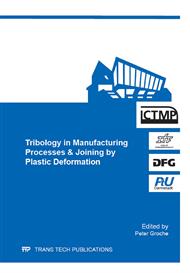p.377
p.386
p.397
p.406
p.425
p.435
p.445
p.453
p.461
Affecting the Life Time of Roller Bearings by an Optimal Surface Integrity Design after Hard Turning and Deep Rolling
Abstract:
The life time of roller bearings can be increased by inducing compressive residual stresses in the subsurface region of the raceway. These stresses can be induced by overloading in the first numbers of revolution. It would be much more useful to create the surface integrity within the manufacturing process. In this paper a method is presented to improve the process chain from grinding and honing to hard turning and deep rolling. As a result the surface finish is comparable to ground bearings. Due to the deep rolling process the maximum compressive stresses can be induced to higher values and depth. For the evaluation of the surface roughness in hard turning process and the maximum compressive stresses in deep rolling empirical models based on D-optimal experimental design are used.
Info:
Periodical:
Pages:
425-434
Citation:
Online since:
June 2014
Authors:
Keywords:
Price:
Сopyright:
© 2014 Trans Tech Publications Ltd. All Rights Reserved
Share:
Citation:


